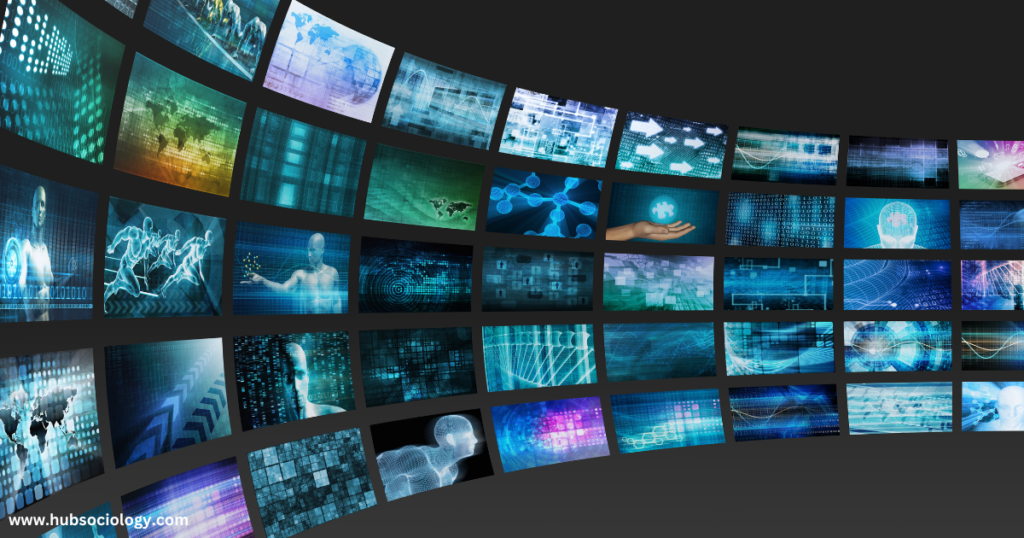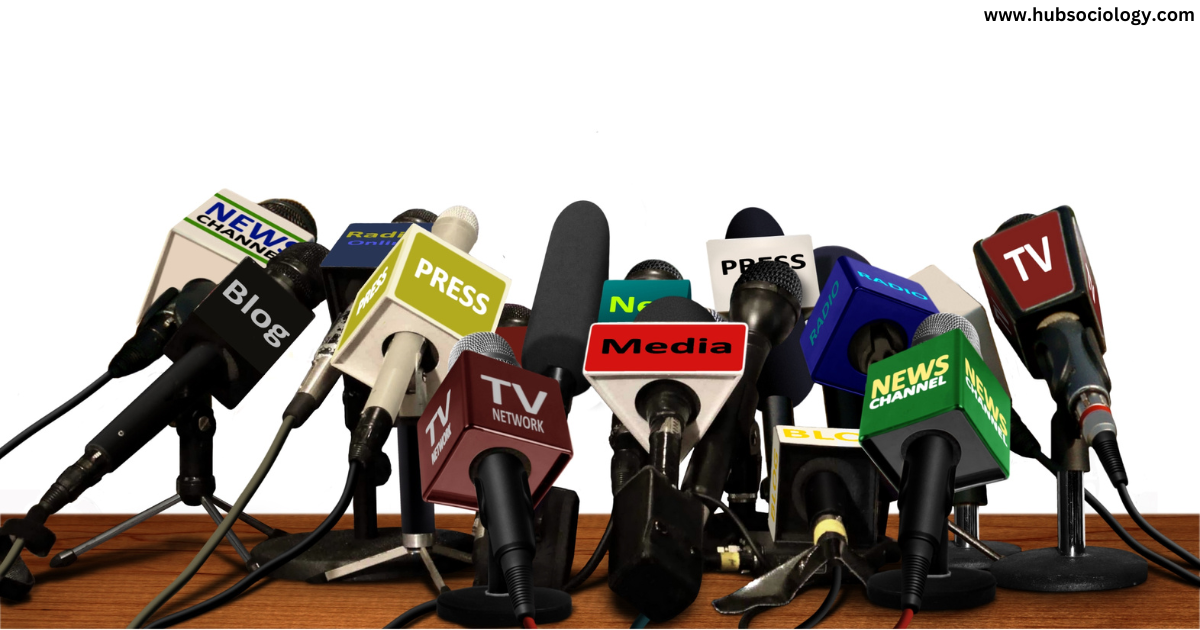Introduction
In the modern era, the media plays a pivotal role in shaping public opinion, cultural norms, and social behavior. The concept of mass society—a large-scale, impersonal, and highly mediated social structure—has become increasingly relevant in understanding how media influences individuals and communities. From television and newspapers to social media and digital platforms, mass communication has transformed the way people interact, perceive reality, and engage in political and social life.

This article explores the relationship between mass society and media influence from a sociological perspective. It examines key theories, the role of media in shaping public consciousness, the effects of media on social control, and the implications for democracy and individual autonomy. By analyzing these dimensions, sociology students can better understand how media functions as a tool of socialization, manipulation, and social change.
1. Understanding Mass Society
Definition and Characteristics
The term mass society refers to a social system in which traditional community ties weaken, and individuals become more isolated, relying heavily on large-scale institutions like government, corporations, and media for information and direction. Key characteristics include:
- Alienation and Anonymity: Individuals feel disconnected from traditional social structures (family, religion, local communities) and instead engage with impersonal institutions.
- Standardization and Homogenization: Mass production, consumer culture, and media create uniform tastes, behaviors, and ideologies.
- Centralized Authority: Power is concentrated in bureaucratic organizations, including media conglomerates that shape public discourse.
Theoretical Perspectives on Mass Society
Several sociological theories explain the rise and implications of mass society:
- Classical Theory (Tönnies, Durkheim)
- Ferdinand Tönnies distinguished between Gemeinschaft (community) and Gesellschaft (society), arguing that modern societies lose intimate bonds in favor of impersonal relations.
- Émile Durkheim discussed anomie—a sense of normlessness—where rapid social changes lead to weakened social regulation.
- Critical Theory (Adorno, Horkheimer)
- The Frankfurt School argued that mass culture and media serve as tools of capitalist domination, promoting consumerism and passive acceptance of authority.
- They introduced the concept of the culture industry, where media produces standardized content to manipulate public desires.
- Postmodern Theory (Baudrillard)
- Jean Baudrillard emphasized hyperreality, where media representations become more real than actual reality, shaping perceptions and behaviors.
2. Media Influence in Mass Society
Media acts as a primary agent of socialization, influencing how people perceive the world. Its impact can be analyzed through various sociological lenses:
A. Agenda-Setting and Framing
- Agenda-Setting Theory (McCombs & Shaw): Media doesn’t tell people what to think but what to think about by selecting and emphasizing certain issues.
- Framing: Media presents information in specific ways to influence interpretation (e.g., portraying protests as “riots” vs. “peaceful demonstrations”).
B. Cultivation Theory (Gerbner)
- Television and digital media cultivate perceptions of reality over time.
- Example: Heavy exposure to crime shows may lead viewers to overestimate real-world violence.
C. Spiral of Silence (Noelle-Neumann)
- People are less likely to express minority opinions due to fear of isolation, leading media to amplify dominant views and suppress dissent.
D. Media and Social Control
- Hegemony (Gramsci): Media reinforces the ideologies of the ruling class, making them appear natural and legitimate.
- Propaganda Model (Herman & Chomsky): Corporate media serves elite interests through filters like ownership, advertising, and sourcing.
3. Media, Democracy, and Public Opinion
A. The Role of Media in Democracy
- Ideal Function: Media should inform citizens, facilitate debate, and hold power accountable (Fourth Estate).
- Reality: Media often prioritizes profit, sensationalism, and partisan bias, undermining democratic deliberation.
B. The Rise of Fake News and Misinformation
- Digital media accelerates the spread of false information, polarizing societies.
- Algorithms create echo chambers, reinforcing pre-existing beliefs.
C. Media and Political Manipulation
- Manufacturing Consent: Media shapes public opinion to support elite agendas (e.g., war propaganda).
- Populism and Media: Politicians exploit media to spread divisive rhetoric (e.g., Trump’s Twitter usage).

4. Psychological and Behavioral Effects of Media
A. Desensitization and Violence
- Studies link violent media exposure to increased aggression (Bandura’s Bobo Doll Experiment).
- However, critics argue correlation ≠ causation.
B. Consumerism and Advertising
- Media promotes materialism, creating artificial needs (Marcuse’s “False Needs” concept).
- Advertising reinforces gender stereotypes and unrealistic beauty standards.
C. Social Media and Mental Health
- Platforms like Instagram and TikTok contribute to anxiety, depression, and low self-esteem through comparison culture.
- FOMO (Fear of Missing Out) drives compulsive media consumption.
5. Resistance and Alternative Media
Despite media’s dominant influence, resistance exists:
- Independent Journalism: Outlets like The Intercept challenge corporate narratives.
- Social Movements: #BlackLivesMatter, #MeToo used media to amplify marginalized voices.
- Media Literacy Education: Critical thinking skills help individuals decode media messages.
Conclusion
The relationship between mass society and media influence is complex and multifaceted. While media serves as a vital tool for information and connectivity, it also reinforces power structures, manipulates public opinion, and contributes to social alienation. Sociological theories provide critical frameworks for understanding these dynamics, emphasizing the need for media literacy and democratic media reform.
As future sociologists, students must critically engage with media, questioning its narratives and advocating for more inclusive, transparent communication systems. Only through such awareness can societies mitigate the negative effects of media while harnessing its potential for positive social change.

Topic Related Questions
5-Mark Questions (Short Answer)
- Define mass society and list its key characteristics.
- Explain the concept of the “culture industry” as proposed by Adorno and Horkheimer.
- What is agenda-setting theory in media studies?
- How does cultivation theory explain media’s influence on perceptions of reality?
- What is the “spiral of silence” theory in mass communication?
- Briefly describe Gramsci’s concept of hegemony in media.
- How does media contribute to political socialization?
- What is hyperreality according to Baudrillard?
- How does advertising reinforce consumerism in mass society?
- What are echo chambers in social media?
10-Mark Questions (Brief Essay/Explanation)
- Discuss the Frankfurt School’s critique of mass media and its role in capitalist society.
- Explain the propaganda model of media (Herman & Chomsky) with examples.
- How does media framing influence public opinion? Provide examples.
- Analyze the impact of social media on democracy, with reference to fake news and polarization.
- Discuss the relationship between media and social control using Gramsci’s hegemony theory.
- How does media contribute to the standardization of culture in mass society?
- Examine the psychological effects of media violence using Bandura’s social learning theory.
- What is the role of alternative media in challenging corporate media dominance?
- How does the “spiral of silence” affect political discourse in mass society?
- Discuss the impact of media on gender stereotypes with examples.
15-Mark Questions (Long Essay/Critical Analysis)
- Critically examine the role of mass media in shaping public opinion and democracy.
- Evaluate the Frankfurt School’s argument that mass media promotes passive conformity in capitalist societies.
- How does digital media reinforce or challenge traditional power structures in mass society?
- “Media does not tell people what to think, but what to think about.” Discuss this statement with reference to agenda-setting and framing theories.
- Analyze the impact of social media algorithms on political polarization and public discourse.
- To what extent does media contribute to the alienation of individuals in mass society?
- Discuss the role of media in manufacturing consent, with reference to Chomsky and Herman’s propaganda model.
- How has the rise of fake news and disinformation affected trust in media institutions?
- Examine the relationship between consumer culture and mass media in contemporary society.
- “Mass media is both a tool of oppression and a means of resistance.” Critically evaluate this statement.
Additional Discussion Questions (For Debates/Seminars)
- Is social media a democratizing force or a tool for manipulation?
- Should governments regulate media to prevent misinformation?
- How can media literacy combat the negative effects of mass media?
- Does mass media promote cultural homogenization or diversity?
Conceptual & Definition-Based (5 Marks)
- Differentiate between mass society and community-based society using Tönnies’ framework.
- What is media logic and how does it shape news production?
- Define filter bubbles and their impact on information consumption.
- How does commodification apply to media content in capitalist societies?
- Explain media dependency theory in one paragraph.
Theoretical Analysis (10 Marks)
- Compare Marx’s false consciousness with Gramsci’s hegemony in media analysis.
- How does postmodernism interpret the role of media in constructing reality?
- Analyze McLuhan’s “the medium is the message” in the context of TikTok/Instagram.
- Apply Durkheim’s anomie to explain alienation in digital media societies.
- Evaluate Habermas’ public sphere theory in the age of Twitter/X.
Media & Power (10-15 Marks)
- “Media ownership concentration threatens democracy.” Discuss with examples.
- How do state and corporate interests intersect in media censorship?
- Analyze how news sensationalism distorts public perception of crises.
- Why is gatekeeping a critical concept in understanding media bias?
- Discuss Edward Herman’s 5 filters in today’s clickbait-driven media.
Digital Media & Society (15 Marks)
- “Social media has made mass society more fragmented than unified.” Critically assess.
- How do algorithms reinforce ideological polarization? Use Bourdieu’s field theory.
- Examine surveillance capitalism (Zuboff) and its link to media platforms.
- Does user-generated content democratize media or amplify misinformation?
- TikTok activism vs. traditional movements: A new era of social change?
Psychological/Social Effects (10-15 Marks)
- Link Gerbner’s mean world syndrome to rising societal anxiety.
- How does social media addiction reflect Durkheimian anomie?
- Analyze body image issues through the lens of media cultivation theory.
- “Video games normalize violence.” Critically engage with this debate.
- Does cancel culture reflect media’s power to enforce norms?
Resistance & Alternatives (10 Marks)
- How effective are fact-checking initiatives in combating fake news?
- Evaluate community radio as a counter-hegemonic media tool.
- Can memes be a form of political resistance? Discuss with examples.
- Deepfake technology: A threat to democracy or artistic freedom?
- Propose strategies to make media more inclusive and participatory.
Case Study-Based Questions (15 Marks)
- Analyze Fox News or Al Jazeera through the propaganda model.
- How did media coverage shape perceptions of COVID-19?
- Study #BlackLivesMatter as a media-driven movement.
- Compare China’s Great Firewall and EU’s GDPR as media control models.
- How did Cambridge Analytica exploit mass society traits?
Ethical/Normative Questions (Debates)
- Should governments ban algorithmic amplification to protect democracy?
- Is media literacy education more effective than regulation?
- Does freedom of speech justify harmful content on social media?
- Should news media be profit-driven or publicly funded?
- Can AI-generated content deepen mass society’s alienation?
Bonus: Essay Prompts (20 Marks)
- “Mass media is the opium of the people in neoliberal societies.” Discuss.
- Trace how media evolved from Gutenberg’s press to Meta’s metaverse in shaping mass society.
- Feminist critique: How does media perpetuate patriarchal norms?
- Is disinformation an inevitable byproduct of mass society?
- Propose a sociological model for ethical media in 2030.
